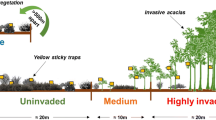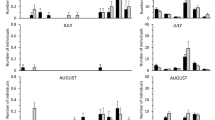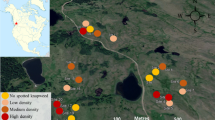Abstract
Invasive plant species generally reduce the abundance and diversity of local plant species, which may translate into alterations at higher tropic levels, such as arthropods. Due to the diverse functional roles of arthropods in the ecosystems, it is critical to understand how arthropod communities are affected by plant invasions. Here, we investigated the impact of the invasive ornamental herb Lupinus polyphyllus (Lindl.) on arthropod communities during its main flowering period in southwestern Finland over two years. The total number of arthropods was about 46% smaller at the invaded sites than at the uninvaded sites in both study years, and this difference was mainly due to a lower abundance of beetles, Diptera, Lepidoptera, and ants. However, the number of bumblebees (particularly Bombus lucorum) was about twice as high at invaded sites compared with uninvaded sites, even though bumblebee richness did not differ between sites. There was no statistically significant difference between invaded and uninvaded sites in the abundances of the other arthropod groups considered (Hymenoptera (excluding bumblebees and ants), Hemiptera, and Arachnida). In addition, L. polyphyllus affected the relative abundance of four arthropod groups, with the order Lepidoptera being less common at invaded sites than at uninvaded sites, while the opposite was true for bumblebees, Hemiptera, and Arachnida. Overall, these results demonstrate that the negative impact of L. polyphyllus on biodiversity goes beyond its own trophic level, suggesting that this species has the potential to alter the abundance of different arthropod groups and, consequently, the structure of arthropod communities at a large scale.


Similar content being viewed by others
References
Bartomeus I, Vilá M, Santamaría L (2008) Contrasting effects of invasive plants on in plant-pollinator networks. Oecologia 155:761–770. doi:10.1007/s00442-007-0946-1
Baum KA, Wallen KE (2011) Potential bias in pan trapping as a function of floral abundance. J Kansas Entomol Soc 84:155–159
Dinnage R, Cadotte MW, Haddad NM, Crutsinger GM, Tilman D (2012) Diversity of plant evolutionary lineages promotes arthropod diversity. Ecol Lett 15:1308–1317. doi:10.1111/j.1461-0248.2012.01854.x
DiTomaso JM (2000) Invasive weeds in rangelands: species, impacts and management. Weed Sci 48:255–265. doi:10.1614/0043-1745(2000)048[0255:IWIRSI]2.0.CO;2
Dutra HP, Barnett K, Reinhardt JR, Marquis RJ, Orrock JL (2011) Invasive plant species alters consumer behavior by providing refuge from predation. Oecologia 166:649–657. doi:10.1007/s00442-010-1895-7
Elleriis P, Pedersen ML, Toft S (2015) Impact of invasive Rosa rugosa on the arthropod fauna of Danish yellow dunes. Biol Invasions 17:3289–3302. doi:10.1007/s10530-015-0953-9
Fenesi A, Vágási CI, Beldean M, Földesi R, Kolcsár L-P, Shapiro JT, Török E, Kovács-Hostyánszki A (2015) Solidago canadensis impacts on native plant and pollinator communities in different-aged old fields. Basic Appl Ecol 16:335–346. doi:10.1007/s10530-015-0954-8
Folgarait PJ (1998) Ant biodiversity and its relationship to ecosystem functioning: a review. Biod Conserv 7:1221–1244. doi:10.1023/A:1008891901953
Fremstad E (2010) NOBANIS—invasive alien species fact sheet—Lupinus polyphyllus.—From: online database of the European Network on Invasive Alien Species—NOBANIS www.nobanis.org. Accessed Nov 24th 2016
Haddad NM, Tilman D, Haarstad J, Ritchie M, Knops JMH (2001) Contrasting effects of plant species richness and composition on insect communities: a field experiment. Am Nat 158:17–35. doi:10.1086/320866
Haynes J, Mesler M (1984) Pollen foraging by bumblebees: foraging patterns and efficiency on Lupinus polyphyllus. Oecologia 61:249–253. doi:10.1007/BF00396768
Hegland SJ, Totland Ø (2008) Is the magnitude of pollen limitation in a plant community affected by pollinator visitation and plant species specialisation levels? Oikos 117:883–891. doi:10.1111/j.2008.0030-1299.16561.x
Hejda M, Pyšek P, Jarošik V (2009) Impact of invasive plants on the species richness, diversity and composition of invaded communities. J Ecol 97:393–403. doi:10.1111/j.1365-2745.2009.01480.x
Herron-Sweet CR, Lehnhoff EA, Burkle LA, Littlefield JL, Mangold JM (2016) Temporal- and density-dependent impacts of an invasive plant on pollinators and pollination services to a native plant. Ecosphere 7:Article e01233. doi:10.1002/ecs2.1233
Hodkinson ID, Jackson JK (2005) Terrestrial and aquatic invertebrates as bioindicators for environmental monitoring, with particular reference to mountain ecosystems. Environ Manag 35:649–666. doi:10.1007/s00267-004-0211-x
Jakobsson A, Padrón B (2014) Does the invasive Lupinus polyphyllus increase pollinator visitation to a native herb through effects on pollinator population sizes? Oecologia 174:217–226. doi:10.1007/s00442-013-2756-y
Jakobsson A, Padrón B, Ågren J (2015) Distance-dependent effects of the invasive Lupinus polyphyllus on pollination and reproductive success of two native herbs. Basic Appl Ecol 16:120–127. doi:10.1016/j.baae.2014.12.005
Kajzer-Bonk J, Spiłyk D, Woyciechowski M (2016) Invasive goldenrods affect abundance and diversity of grassland ant communities (Hymenoptera: Formicidae). J Insect Conserv 20:99–105. doi:10.1007/s10841-016-9843-4
Litt AR, Cord EE, Fulbright TE, Schuster GL (2014) Effects of invasive plants on arthropods. Conserv Biol 28:1532–1549. doi:10.1111/cobi.12350
Lopezaraiza-Mikel ME, Hayes RB, Whalley MR, Memmott J (2007) The impact of an alien plant on a native plant-pollinator network: an experimental approach. Ecol Lett 10:539–550. doi:10.1111/j.1461-0248.2007.01055.x
Losey JE, Vaughan M (2006) The economic value of ecological services provided by insects. Bioscience 56:311–323
Masters JA, Emery SM (2015) The showy invasive plant Ranunculus ficaria facilitates pollinator activity, pollen deposition, but not always seed production of two native spring ephemeral plants. Biol Invasions 17:2329–2337. doi:10.1007/s10530-015-0878-3
McKinney AM, Goodell K (2010) Shading by invasive shrub reduces seed production and pollinator services in a native herb. Biol Invasions 12:2751–2763. doi:10.1007/s10530-009-9680-4
Meier CI, Reid BL, Sandoval O (2013) Effects of the invasive plant Lupinus polyphyllus on vertical accretion of fine sediment and nutrient availability in bars of the gravel-bed Paloma river. Limnologica 43:381–387. doi:10.1016/j.limno.2013.05.004
Molina-Montenegro MA, Badano EI, Cavieres LA (2008) Positive interactions among plant species for pollinator service: assessing the ‘magnet species’ concept with invasive species. Oikos 117:1833–1839. doi:10.1111/j.0030-1299.2008.16896.x
Muños AA, Cavieres LA (2008) The presence of a showy invasive plant disrupts pollinator service and reproductive output in native alpine species only at high densities. J Ecol 96:459–467. doi:10.1111/J.1365-2745.2008.01361.X
Pearson DE (2009) Invasive plant architecture alters trophic interactions by changing predator abundance and behavior. Oecologia 159:549–558. doi:10.1007/s00442-008-1241-5
Pohtio I, Teräs I (1995) Bumblebee visits to different colour morphs of the Washington lupine, Lupinus polyphyllus. Entomol Fennica 6:139–151
Ramula S, Pihlaja K (2012) Plant communities and the reproductive success of native plants after the invasion of an ornamental herb. Biol Invasions 14:2079–2090. doi:10.1007/s10530-012-0215-z
R Core Team (2016) R: a language and environment for statistical computing. R Foundation for Statistical Computing, Vienna, Austria. https://www.R-project.org/
Russo L, Nichol C, Shea K (2016) Pollinator floral provisioning by a plant invader: quantifying beneficial effects of detrimental species. Divers Distrib 22:189–198. doi:10.1111/ddi.12397
Schirmel J, Bundschuh M, Entling MH, Kowarik I, Buchholz S (2016) Impacts of invasive plants on resident animals across ecosystems, taxa, and feeding types: a global assessment. Glob Change Biol 22:594–603. doi:10.1111/gcb.13093
Tanner RA, Varia S, Eschen R, Wood S, Murphy ST, Gange AC (2013) Impacts of an invasive non-native annual weed, Impatiens glandulifera, on above- and below-ground invertebrate communities in the United Kingdom. PlosOne 8:e67271. doi:10.1371/journal.pone.0067271
Tiedeken EJ, Egan PA, Stevenson PC, Wright GA, Brown MJF, Power EF, Farrell I, Matthews SM, Stout JC (2016) Nectar chemistry modulates the impact of an invasive plant on native pollinators. Funct Ecol 30:885–893. doi:10.1111/1365-2435.12588
Valtonen A, Jantunen J, Saarinen K (2006) Flora and lepidoptera fauna adversely affected by invasive Lupinus polyphyllus along road verges. Conserv Biol 133:389–396. doi:10.1016/j.biocon.2006.06.015
van Hengstum T, Hooftman DAP, Oostermeijer JGB, van Tienderen PH (2014) Impact of plant invasions on arthropod communities: a meta-analysis. J Ecol 102:4–11. doi:10.1111/1365-2745.12176
Vilà M, Espinar JL, Hejda M, Hulme PE, Jarošik V, Maron JL, Pergl J, Schaffner U, Sun Y, Pyšek P (2011) Ecological impacts of invasive alien plants: a meta-analysis of their effects on species, communities and ecosystems. Ecol Lett 14:702–708. doi:10.1111/j.1461-0248.2011.01628.x
Acknowledgements
We are grateful to Evans Effah and Oluwatobi Badejo for identifying the arthropod groups, and to two anonymous reviewers for valuable comments and suggestions. This study was financially supported by the Emil Aaltonen Foundation and the Academy of Finland (#285746 to SR).
Author information
Authors and Affiliations
Corresponding author
Ethics declarations
Conflict of interest
The authors declare that they have no conflict of interest.
Additional information
Handling Editor: Kristine Nemec.
Rights and permissions
About this article
Cite this article
Ramula, S., Sorvari, J. The invasive herb Lupinus polyphyllus attracts bumblebees but reduces total arthropod abundance. Arthropod-Plant Interactions 11, 911–918 (2017). https://doi.org/10.1007/s11829-017-9547-z
Received:
Accepted:
Published:
Issue Date:
DOI: https://doi.org/10.1007/s11829-017-9547-z




